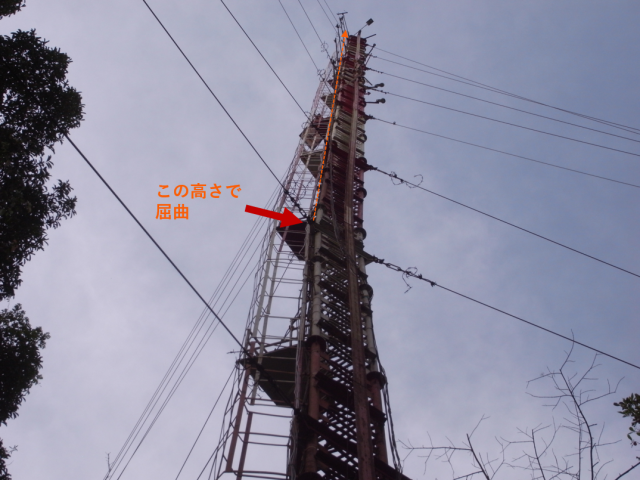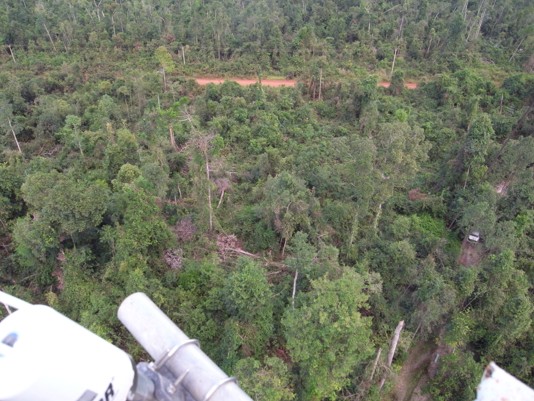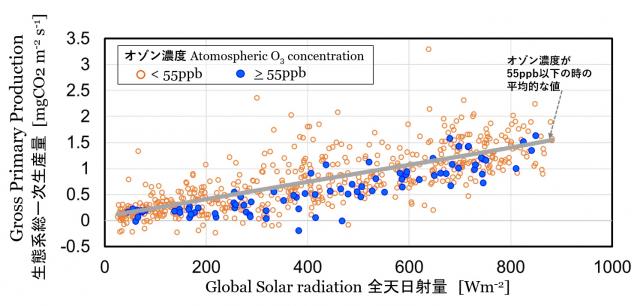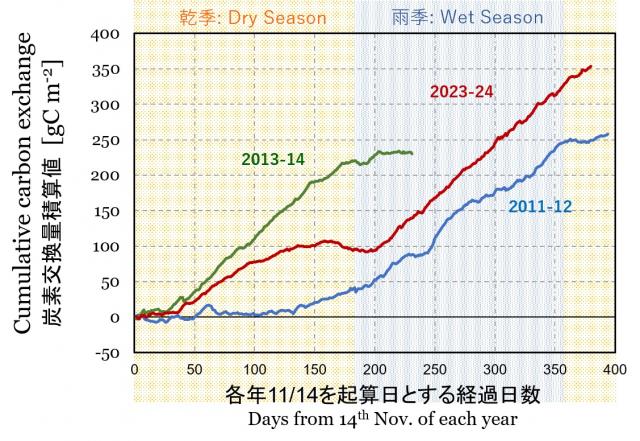Home > International Partnerships > Collaborative Research > Analyzing the Effect of Gradual Ozone Increase under Natural Condition on Water Use Efficiency of Dry Tropical Forest in Cambodia
Update:June 2, 2025
Main content starts here.
Analyzing the Effect of Gradual Ozone Increase under Natural Condition on Water Use Efficiency of Dry Tropical Forest in Cambodia

1. Partners
Forestry Administration, Cambodia
The University of Tokyo, Japan
Kyushu University, Japan
Osaka Prefecture University, Japan
2. Research Period
FY 2020–2024 Grant-in-Aid for Scientific Research (KAKENHI)
3. Lead Researcher
SHIMIZU, Takanori (Department of Disaster Prevention, Meteorology and Hydrology)
4. Background
Carbon dioxide (CO2) and tropospheric ozone concentrations are gradually increasing in the natural atmosphere. From worldwide observations of CO2 and water vapor (H2O) exchange, water use efficiency of forest ecosystems has generally increased with the increase of CO2 concentration. Meanwhile, the increase in tropospheric ozone concentration is considered to cause a decline in the water use efficiency of plants. However, how the increase of ozone affects the water use efficiency of tropical forest ecosystem that occupies more than 20% of global carbon emissions remains unknown. Tropical seasonal forests, although rapidly disappearing due to recent economic development, have been expected to keep their greenhouse gas absorption rate in the future. Therefore, the opposing effects of CO2 and ozone on the water use efficiency of this ecosystem should be evaluated quantitatively.
5. Research Goal
We aim to understand the process of change in water use efficiency and to develop a tool for estimating the future effects of gradual ozone increase on the forest water use efficiency. The Cambodian tropical dry evergreen forest will serve as an indicator ecosystem for these studies.
6. Research Strategy
- To evaluate the water use efficiency of the forest ecosystems, observations of the CO2 /H2O exchange rate and ozone concentration will be conducted over the forest canopy.The observation system will first be tested at a planted forest in Japan and then applied to dry evergreen forests in Cambodia.
- Other comprehensive observations such as factors related to micro-meteorology, water budget and carbon cycle in dry evergreen forests in Cambodia will be conducted.
- The effect of ozone increase on water use efficiency will be analyzed. Model parameters will be fitted for prediction of future water use efficiency trend.
7. Scientific Achievement
This research project was hit by the COVID-19 pandemic just after when it started, and further, the observation tower and basic instruments were severely damaged during that time, which resulted in a significant delay in installation of an H2O/CO2 exchange observation system in the tropical dry evergreen forest (Photo 1). In the midst of this, we conducted test observations in Japan, and found that when atmospheric ozone concentrations increased in cedar and cypress artificial forests from February to March, the amount of GPP (gross primary production) slightly decreased (Fig.1). The results implied that even cedar and cypress, which have traditionally been considered to be highly resistant to ozone, have periods when their sensitivity to ozone increases.
During the latter half of the research period when on-site observations became possible, forest logging had progressed around the observation site, and the forest had begun to degrade (Photo 2). Under such conditions, observation of CO2 exchange could be conducted and the seasonal variation of NEE (net ecosystem exchange) was estimated. The recent NEE was compared with that obtained when the forest was relatively in healthy state. As a result, it was found that the CO2 exchange obtained recently remained within the range of annual fluctuations when the forest was healthy (Fig. 2). We plan to track how this value will change in the future, along with the trends in ozone concentrations.

Photo 1: The observation tower bent during the COVID-19 pandemic (photo taken October 2022).

Photo 2: The forest status below the observation tower (photo taken in November 2023).

Figure 1: Relationship between gross primary production estimated from CO2 flux observation above Japanese cedar & cypress forest in Japan and global solar radiation.

Figure 2: Accumulated carbon exchanges of recent years (2023-24, when the forest degradation has begun) and those of the former years when the forest were relatively healthy.
8. Applications
The estimated carbon dioxide exchange rate in the forest was published in the data paper. It is expected that the knowledge on carbon sequestration of tropical dry forest in Southeast Asia serve as a forest management guideline for researchers in and outside of Cambodia. The results were also reported to the Forestry Agency of the Kingdom of Cambodia, and MOU was extended to promote the development of a cooperation for forest research.
9. Publications
Shimizu, T., Iida, S., Kabeya, N., Miyazawa, Y., Ueyama, M., Kumagai, T. (2024) Relationship between atmospheric O3 concentration and H2O/CO2 exchanges above a planted coniferous forest in Japan. 134th Annual JFS Meeting, 272.
Shimizu, T., Ito, E., Kabeya, N., Iida, S., Miyazawa, Y., Kenzo, T., Ueyama, M., Tamai, K., Ohnuki, Y., Shimizu, A. (2025) CO2 budget in tropical dry evergreen forests that are undergoing degradation: How has it changed since before and after degradation? 135th Annual JFS Meeting, 155.
Ueyama, M., Takao, Y., Yazawa, H., Tanaka, M., Yabuki, H., Kumagai, T., Iwata, H., Awal, Md. A., Du, M., Harazono, Y., Hata, Y., Hirano, T., Hiura, T., Ide, R., Ishida, S., Ishikawa, M., Kitamura, K., Kominami, Y., Komiya, S., Kotani, A., Inoue, Y., Machimura, T., Matsumoto, K., Matsuura, Y., Mizoguchi, Y., Murayama, S., Nagano, H., Nakai, T., Nakaji, T., Nakaya, K., Ohkubo, S., Ohta, T., Ono, K., Saitoh, T. M., Sakabe, A., Shimizu, T., Shimoda, S., Sugita, M., Takagi, K., Takahashi, Y., Takamura, N., Takanashi, S., Takimoto, T., Yasuda, Y., Wang, Q., Asanuma, J., Hasegawa, H., Hiyama, T., Iijima, Y., Ishidoya, S., Itoh, M., Kato, T., Kondo, H., Kosugi, Y., Kume, T., Maeda, T., Maximov, T., Moriwaki, R., Muraoka, H., Petrov, R., Suzuki, J., Taniguchi, S., and Ichii, K.(2025) The JapanFlux2024 dataset for eddy covariance observations covering Japan and East Asia from 1990 to 2023, Earth Syst. Sci. Data (Accepted).
Copyright © Forest Research and Management Organization. All rights reserved.
